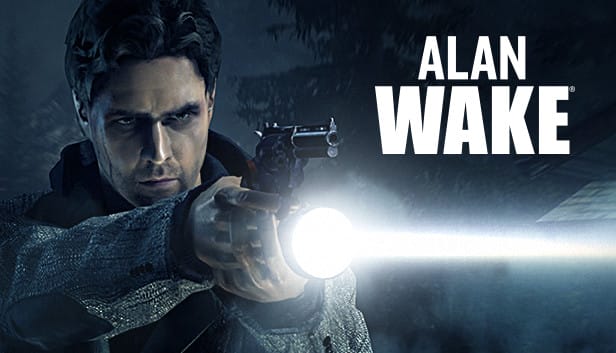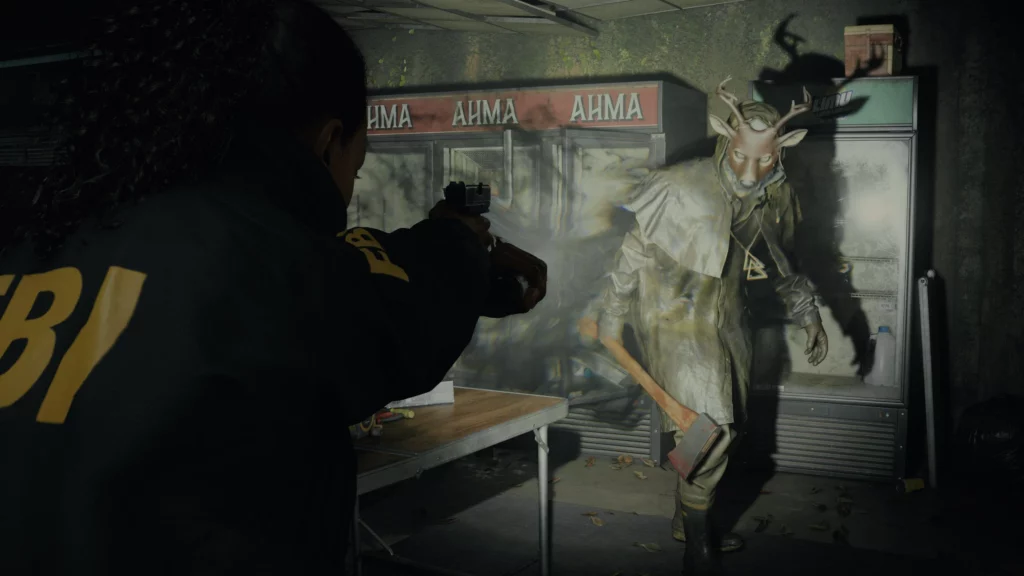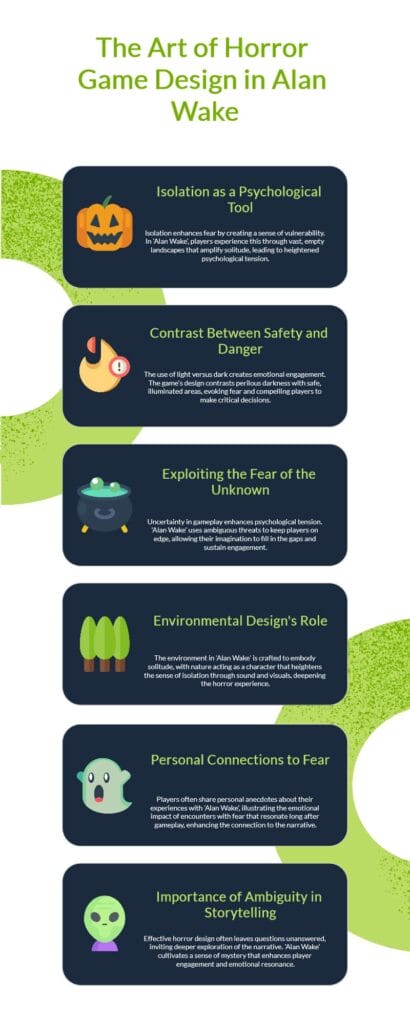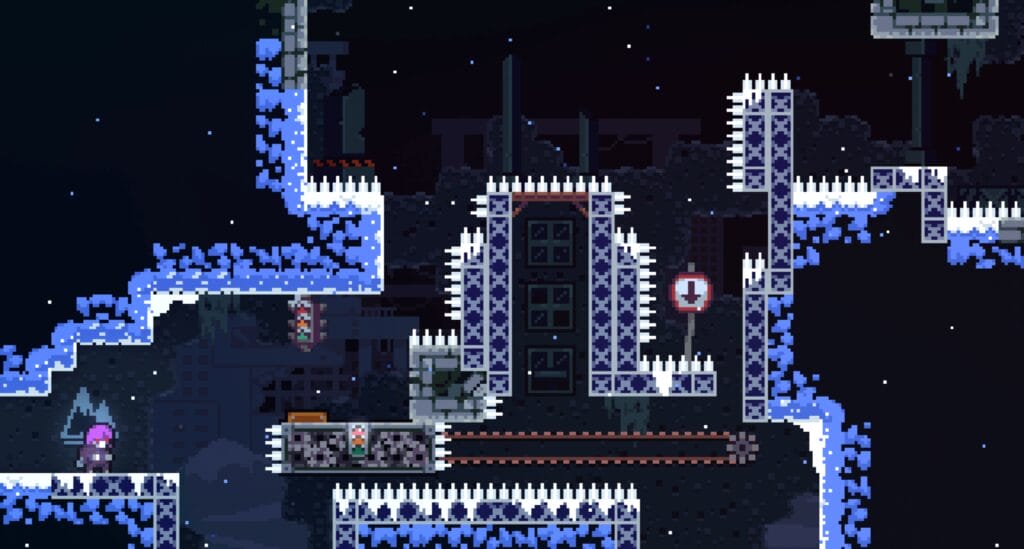Crafting Fear in Virtual Worlds: Lessons from a Psychological Thriller
In the realm of video games few genres captivate players like horror. The art of scaring gamers isn’t just about jump scares and monsters lurking in shadows. It’s a nuanced craft that delves into human psychology weaving together elements of design storytelling and player engagement. Today we’ll explore how one game Alan Wake masterfully employs these techniques to create an unforgettable experience. The article is based on a Twitter (X) thread found while browsing for good information on game design.
Article Key Takeaways:
- Isolation amplifies fear by creating vulnerability and psychological tension
- Contrast between safety and danger heightens player engagement
- Fear of the unknown taps into deep-rooted human anxieties enhancing gameplay
- Ambiguous threats in Alan Wake foster player imagination and dread
- Effective horror design leaves questions unanswered prolonging emotional impact

The Principle of Isolation: Alone in the Dark
Isolation serves as a cornerstone in horror gaming. It’s not merely a backdrop but an active player in the psychological drama unfolding on screen. When characters find themselves cut off from help or safety every noise becomes amplified every shadow a potential threat. This heightened awareness taps into our primal fears making the gaming experience visceral and intense.
Psychological Tension Through Solitude
In Alan Wake players often find themselves wandering through shadowy woods enveloped by an eerie silence. This intentional design choice isolates players both physically and mentally. The vast empty landscapes not only disorient but also create an overwhelming sense of being trapped in a desolate world. 😨
“Isolation in gameplay isn’t just setting; it’s the core of player anxiety.” – Game Designer
This sentiment echoes through every creaking floorboard and rustling leaf underscoring how solitude shapes the very essence of horror gaming.
Environmental Design: Nature as a Character
The game excels at creating environments that embody solitude. The woods aren’t just a backdrop; they become a character unto themselves integral to the narrative. Designers employ various techniques to amplify this sense of isolation:
- Vast expanses of nature that feel alive yet indifferent
- Masterful use of darkness with few light sources providing false security
- Sound design that emphasizes every twig snap and whisper of wind
These elements combine to keep players in a constant state of alert aware that danger could lurk around any corner.
Personal Anecdotes: When Gaming Gets Too Real
Many gamers have stories about moments in Alan Wake that made their skin crawl. One player recalls their first encounter with the Darkness—an entity that not only pursues the protagonist but symbolizes the weight of isolation itself. The sensation of being hunted paired with the haunting solitude of the landscape creates memories that linger long after the console is turned off.
This experience isn’t unique to Alan Wake. Other titles like Silent Hill and Outlast also utilize isolation effectively leaving players feeling vulnerable and alone. Each game serves to enrich our understanding of how solitude reshapes narratives allowing for personal interpretations and emotional responses.

The Impact of Contrast: Light vs. Dark Safety vs. Danger
Contrast serves as a powerful tool in crafting atmospheres that elicit genuine fear and unease. Games like Alan Wake exemplify how strategic contrast can highlight stark differences between danger and safety guiding player perception and emotional responses.
Highlighting Danger and Safety
By juxtaposing elements of danger against those of safety developers create a visual and emotional tug-of-war that engages players. In Alan Wake players often confront perilous scenarios cloaked in darkness contrasted by beams of light symbolizing sanctuary. This design strategy aligns with psychological principles regarding fear creating a thrilling experience.
The contrast extends beyond lighting to level design layouts. Players may find themselves isolated in dark foreboding areas only to encounter safe havens offering comfort and light. This dynamic keeps players on edge never allowing them to fully relax.
Color and Lighting: The Secret Weapons of Fear
Color and lighting act as primary modes of contrast within Alan Wake. The game’s developers take advantage of:
- Bright soft colors signaling safety or moments of reprieve
- Deep shadows and muted tones conveying danger and foreboding
This use of color theory not only aids in storytelling but also manipulates the player’s emotional state. The game frequently navigates fluid transitions between day and night. During daylight players relish a sense of security; however as night falls contrasted dangers lurk in the shadows. 🌓
Psychological Principles at Play
Understanding the psychological underpinnings of contrast provides deeper insights into why these techniques evoke fear so effectively. When extremes are encountered—be it light vs. dark safety vs. danger—human beings naturally react more intensely. This phenomenon compels players to think critically about their next moves fostering a heightened sense of awareness and dread.
Developers use this principle to craft scenarios where players must make decisions based on their understanding of contrast. Should they step into the well-lit room that appears safe or linger in the darkened hallway aware it may contain hidden terrors? The constant weighing of risks creates an engaging tension that captivates players throughout their journey.
Fear of the Unknown: Harnessing Player Emotions
The fear of the unknown is a powerful theme that permeates human psychology especially in horror gaming. This principle not only fuels player imagination but also cultivates an atmosphere of suspense and anxiety keeping players on edge.
The Psychological Mechanics of Fear
Fear can be dissected into various components one of which is the profound anxiety that stems from uncertainty. When players encounter ambiguous threats their minds race with possibilities filling the void of knowledge with their worst imaginings. This is particularly evident in Alan Wake where uncertainty serves as a vehicle to enhance player experience.
As players navigate the darkened woods of Bright Falls they often find themselves confronted with shadowy figures lurking just beyond their line of sight. These moments not only elicit dread but also catalyze player engagement as they attempt to piece together narratives and confront fears that remain largely undefined.
Examples of Ambiguous Threats in Alan Wake
Alan Wake masterfully implements the concept of fear through its design and storytelling techniques. A key aspect of its horror lies in the presentation of ambiguous threats. Players frequently encounter mysterious figures obscured by darkness; their forms are seldom fully revealed instilling a sense of vulnerability and fear.
This technique forces players to confront their imagination creating a personal horror that feels unique to each individual. Consider moments where Alan’s path is momentarily illuminated only to reveal unsettling creatures poised to attack the moment the light fades. It is this careful balance of visibility and obscurity that fosters a constant state of apprehension.
Such ambiguity is not confined to just visual design. In-game documents play a pivotal role in world-building often offering snippets of lore without providing full answers. Players may uncover diaries or articles that reference past occurrences or hint at forthcoming threats yet never deliver a clear narrative. This encourages players to explore more immersing themselves deeper into the story and fostering their own interpretations.
Personal Experiences with Dread
Reflecting on personal gaming experiences the moments that stand out often revolve around encounters with the unknown. One might recall wandering through dimly lit hallways in early horror games pausing at every sound and shadow questioning whether it is safe to proceed. These experiences are universal among gamers serving as a reminder of how effectively ambiguity can catalyze player engagement.
The sensation of being watched or pursued even when clear threats are absent exemplifies how fear of the unknown physically manifests during gameplay. Moreover these experiences extend into the realm of narrative. Games that leave answers unresolved often resonate more profoundly with players. An unanswered question—such as the true nature of a haunting or the motives behind an antagonist—can linger in a player’s mind long after the gaming session concludes illustrating the lasting impact of uncertainty.

Conclusion: The Art of Leaving Questions Unanswered
The fear of the unknown is a critical element in horror game design. It not only draws upon player psychology to create suspense and paranoia but also enriches storytelling by leaving room for interpretation. As seen in Alan Wake employing ambiguous threats and hinting at larger mysteries can elevate the horror experience cultivating a narrative that lingers long after the game is over.
“The unknown is where the real terror lies; it invokes our deepest fears.” – Game Theorist
Ultimately as game designers strive to develop landscapes filled with dread and uncertainty they must not overlook the power of the unknown in harnessing player emotions. By embracing this principle they open a gateway to a deeply immersive and unforgettable gaming experience.
In conclusion Alan Wake serves as a masterclass in horror game design. Through its expert use of isolation contrast and the fear of the unknown it creates an atmosphere that keeps players engaged and terrified in equal measure. As we’ve explored these elements work together to craft a psychological thriller that resonates on a deep emotional level leaving players with an experience that’s hard to shake off.
Whether you’re a game designer looking to create your own horror masterpiece or a player seeking to understand the mechanics behind your favorite scary games the lessons from Alan Wake offer invaluable insights into the art of digital dread. So next time you find yourself alone in a dark virtual forest remember: the real horror isn’t just what you see but what you don’t. 😱


















